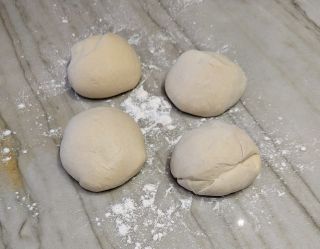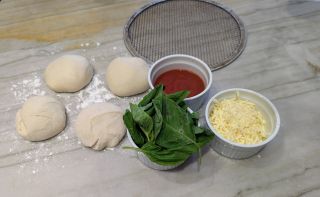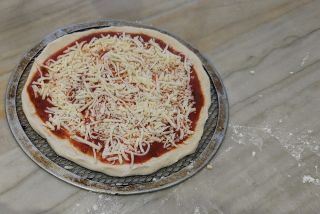Happiness
The Hope of Change
... and the rising power of pizza.
Posted June 7, 2023 Reviewed by Gary Drevitch
Key points
- The hope of change encourages us to navigate the unknown to get to the other side of experiences we want.
- A pizza recipe embodies transformation, as a mass of dough changes into something delicious.

It’s Monday morning. I’m headed to the pool and kind of dreading it.
It’s not the swimming I dislike, it’s the quiet pain of getting into a cold pool. The water’s not freezing, I’ve swum in worse, but it’s cold enough to wake you up with each submerging step.
Ugh. I act causal as people swim by. Don’t they realize the water is cold? Am I the only one struggling to get in?
A fast swimmer skids down the lane, splashing with his quick kicks. “It’s the slow lane!” I want to shout. Hopefully, the lifeguard will re-direct him.
The thing is, I’ve been swimming my whole life. I honestly don’t know why this cold water thing is so difficult.
Here comes splash guy again. “You’ve got this,” I will myself.
The initial dread slowly dissipates with each lap. The water begins to feel comfortable, like the warm taste of cheesy pizza. I’m reminded of why I’m here. Even splash guy seems less important.
Then “Oh no—what’s that?” A flowered garnishment floats nearby. It looks embarrassingly familiar.
“Yikes!” it’s the decorative bow from my bathing suit—a new suit I might add. And it wasn’t cheap.
I grab it, a new dread emerging at the thought of having to get out into what is now certain to feel like cold air. I put the bow in my swim bag and rush back into the pool—and what had been cold had now become warm.
The shift made me think about the hope of change. How can what we avoid be transformed into a new experience? How can dread and procrastination be replaced with unexpected warmth and comfort? The “Uh-oh” that shifts into an “Ah ha!”
“What recipe embodies change?” I ask my chef husband Julian.
“Well, pizza, of course,” he responds without hesitation.
Change is complicated. It’s not uncommon to think about what we want to be different in our lives, or the ways our lives would change if just a few things shifted in a certain way.
But change is scary, full of the uncertainty of not knowing what we’ll find when we get to the other side.
Will what we hoped for really turn out to be what we planned? What if we don’t like the change that happens?
The popular saying, “Be careful what you wish for,” doesn’t help. It taunts us in thinking that we might actually get what we want, and then be punished for it. The image of people surrounding us, nodding their heads slowly saying, “Told you so,” comes to mind.
And change has to confront our sitting with the way things are. Business as usual can keep us stuck in place—or literally stuck in motion, like the trepidation of entering a cold pool, or the uncooked pizza dough sitting in our fridge.

But wait—our story isn’t over. There’s hope. That Monday-morning fear of getting into the pool completely shifted when I got out of the water and couldn’t wait to get back in. What was once dread was now welcoming; what was trepidation was now relief.
The unexpected hope that can come with change is like a blob of dough transforming into a warm crust.
It all starts with a flour mixture. We look at it and wonder how this could ever be anything else. But the strands of gluten elongate as we knead the mixture, transforming it into something elastic, stretchy, and ultimately, doughy.
Perhaps anxiety prevents us from navigating uncertainty so we can get to the other side of possibility. It’s an understandable obstacle: We are only human, after all. How do we know the mixture is going to turn out OK?
Sometimes the process of change is accompanied by a quirky unexpectedness that challenges us to go a certain way. We must take the risk and knead our dough. And when we cook it, a chemical reaction occurs—a gas that makes our dough lighter, our edible pizza crust of hope.
What is our chemical reaction? How can we stretch and knead ourselves so that we too can transform in authentic ways?
And here’s the honest pizza-laden truth: The next time I go to that pool, the exact same thing is going to happen all over again (although hopefully another part of my bathing suit won’t fall off).
Change is ongoing, but so is hope.
In this post, I’m inviting us to embrace the hope of change—like the rising power of pizza.
Here’s a recipe based on the one in our book Eating Together, Being Together (Clauss-Ehlers & Clauss-Ehlers, 2022):

Pizza Power
Ingredients
1 cup warm (not hot) water
1 Tbsp granulated sugar
½ Tbsp extra-virgin olive oil
¼ tsp active dry yeast
2 cups 00 pizza flour or bread flour (each is a high-gluten flour)
¾ cup all-purpose flour
1 Tbsp fine sea salt
1 cup good-quality pizza sauce
2 cups shredded low-moisture mozzarella cheese
1/2 cup diced fresh mozzarella cheese
8 fresh basil leaves, torn into small pieces
Serves 4.
48 Hours Before Eating Your Pizza
In a small bowl, whisk together the warm water, sugar, olive oil, and yeast. Let stand for 8 to 10 minutes. In a large bowl, combine the pizza or bread flour, all-purpose flour, and salt. Add the liquid yeast mixture and knead by hand for 5 to 8 minutes, or until smooth and elastic. Cover the bowl with plastic wrap and let stand at room temperature for 1 hour. After 1 hour, divide your dough into 4 equal balls. Place them in a lightly floured container, cover tightly, and refrigerate for 2 days.
Pizza Day
After 2 days, preheat the oven to 475°F and remove the container of dough from the fridge. On a lightly floured surface, use a rolling pin to roll out a ball of your dough until it is thin and round. It can be tricky to make it round because the dough can be thicker in some places than others. Put your dough on a pizza screen. With a spoon, spread your pizza sauce over the dough but leave a ½ inch border around the edge. Sprinkle the grated mozzarella cheese over the tomato sauce and top with a few chunks of fresh mozzarella. Repeat the rolling and topping process until your 4 pizzas are ready to cook.

You’re almost there. Depending on the size of your oven, you may need to bake the pizza in batches. Place your pizza screens in the hot oven and bake for 5 to 8 minutes, depending on your oven. Your pizzas are ready when the dough is lightly brown and the mozzarella is bubbling. Carefully remove your pizzas from the oven and finish with the fresh basil. You did it—no need for pizza delivery! (Clauss-Ehlers & Clauss-Ehlers, 2022, p. 173).
Hopeful!
Concluding Activity: The Hope of Change
We can identify the things we want to change in our lives. Our hope is that we can move toward the transformation we envision for ourselves, like the rising power of pizza. Consider the following activities for all ages.
Young Helpers (toddlerhood through school-age children): The Wow of Change!
Combining ingredients can lead to unexpected creations. Watch what happens after mixing your warm water, sugar, olive oil, and yeast. What do you notice? How do they change?
Preteen and Teen Helpers: Name Your Change
It takes a chemical reaction to make the dough in our pizza recipe, like a spark that leads to a transformative change. Where would you like to ignite that spark in your own life? What change do you want to see? Let pizza be your guide!
Grown-Up Helpers: Bringing Hope
In this pizza recipe, we can visually witness the transformation of ingredients into something yummy that can be shared with others. In a way, pizza symbolizes the change that can happen when we mix things up to create something delicious. What are the ingredients we need in our lives to inspire the hope of change: Support? New friends? Travel? A different career path? And what ingredients can we shed from our lives because they interfere with that hope: A lack of care? Overwhelming stress? The hope of change encourages us to navigate the unknown so we can get to the other side—the transformation of lumpy dough into delectable pizza.
References
Clauss-Ehlers, J.C.E., & Clauss-Ehlers, C.S. (2022). Eating together, being together: Recipes, activities, and advice from a chef dad and psychologist mom. Princeton Architectural Press.




